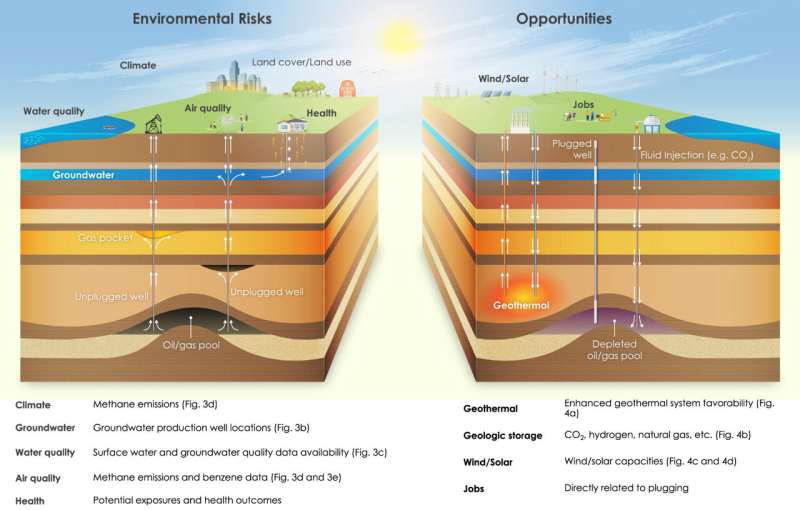This article has been reviewed according to Science X's editorial process and policies. Editors have highlighted the following attributes while ensuring the content's credibility:
fact-checked
peer-reviewed publication
trusted source
proofread
Assessing environmental risks and opportunities of orphaned oil and gas wells

McGill University researchers are leading an international team whose goal is to create a framework to help governments in the U.S. and around the world assess and prioritize remediation strategies for orphaned oil and gas wells.
These inactive wells represent environmental risks since they have the potential to contaminate water supplies, degrade ecosystems, and emit methane and other air pollutants that are harmful to human health. But plugging the wells also offers various potential environmental opportunities such as underground storage of carbon dioxide and hydrogen, or the development of geothermal energy systems.
Dealing with orphaned wells—an incomplete picture and insufficient money
There are hundreds of thousands of orphaned oil and gas wells in the U.S., at least 400,000 in Canada and tens of millions of them around the world. Since the former owners of these abandoned wells cannot be traced or cannot clean up these wells, the responsibility for plugging the wells typically falls to governments who may need further information on how best to manage the orphaned wells.
In November 2021, as part of the Bipartisan Infrastructure Law (BIL), the U.S. government allocated $4.7 billion USD to plug orphaned oil and gas wells across the country.
"While this sounds like a lot of money, we estimate that the costs of plugging the documented orphaned wells in the U.S. will exceed this sum by 30-80% or possibly more," says Mary Kang, an Assistant Professor in the Department of Civil Engineering at McGill University and the senior and lead author of the paper published today in Environmental Research Letters which lays out some of the environmental risks and opportunities of various remediation strategies, as well as the information that still needs to be gathered.
"And it will certainly not cover the large number of orphaned wells which are undocumented—whose very existence we know of but whose exact locations and depth remain unknown. We need to rapidly develop a framework and environmental monitoring datasets to prioritize wells for plugging, since tens of thousands of wells will be plugged in a matter of years."
Over 4.5 million Americans live close to unplugged gas or oil wells
To gain a sense of the larger impacts of these wells and help inform government policies, the researchers analyzed data for over 80,000 documented orphaned oil and gas wells in the U.S. while at the same time looking at available socioeconomic, environmental, and natural resource data. Hundreds of thousands more of these orphaned wells are spread across the country.
They found that over 4.6 million Americans (or about 13% of the nation's population) live within one km (approximately ½ mile) of one of the more than 80,000 documented orphaned gas or oil wells in the U.S. Among this population, at a national level, there was an over-representation of Hispanic/Latino and Native American populations.
The researchers also found that over one third of these wells are at about 1km (or ½ mile) from a domestic groundwater well, though they note that there is generally insufficient data about the potential health risks associated with orphaned wells.
"Recent studies have identified air, water and human health hazards of orphaned oil and gas wells however the literature is not yet extensive enough to quantify the risks of this legacy infrastructure across the country," adds Seth Shonkoff at PSE Healthy Energy.
Environmental opportunities—wind power, subsurface gas storage, and geothermal development
The subsurface is a natural resource like any other and many present-day as well as future applications will require access to subsurface reservoirs that are not compromised by oil or gas leakage. For example, the researchers found that most of the documented orphaned wells (91%) are in areas where geologic formations offer subsurface storage potential for carbon dioxide, hydrogen, and natural gas, as long as they meet security standards.
The researchers also suggest that instead of restoring the surface to pre-development conditions, the land could potentially be repurposed to produce wind power, since almost 75% of the orphaned wells are in areas with top wind capacity. In addition, approximately 33% of orphaned wells are in regions, such as North Dakota, that are considered moderately favorable to geothermal systems and 1% are found in areas such as Utah, Colorado and California that are considered most favorable for geothermal development.
"This analysis shines a light on the need to find, prioritize, plug and remediate orphaned wells—which are often located in close proximity to millions of Americans' homes—and the major task ahead to understand and mitigate their environmental impacts," said Adam Peltz, Director and Senior Attorney at Environmental Defense Fund.
"As Bipartisan Infrastructure Law-funded plugging programs ramp up, this study provides an unprecedented examination of the nature of the documented orphaned well population at a crucial time. These findings also speak to the importance of the pending Abandoned Well Remediation Research and Development Act (AWRRDA) bill in Congress, which has the potential to accelerate research to find and remediate the hundreds of thousands of orphaned wells across the U.S. that remain undocumented."
More information: Mary Kang et al, Environmental risks and opportunities of orphaned oil and gas wells in the United States, Environmental Research Letters (2023). DOI: 10.1088/1748-9326/acdae7
Journal information: Environmental Research Letters
Provided by McGill University




















